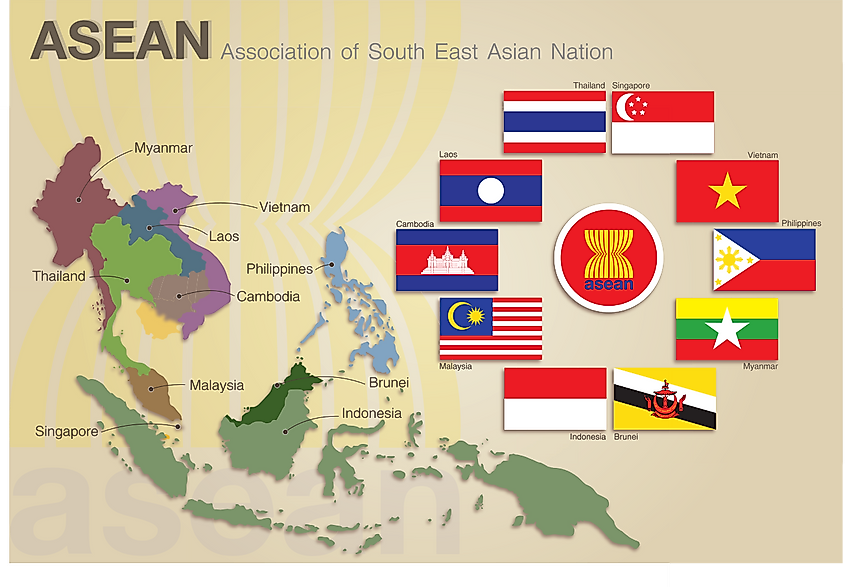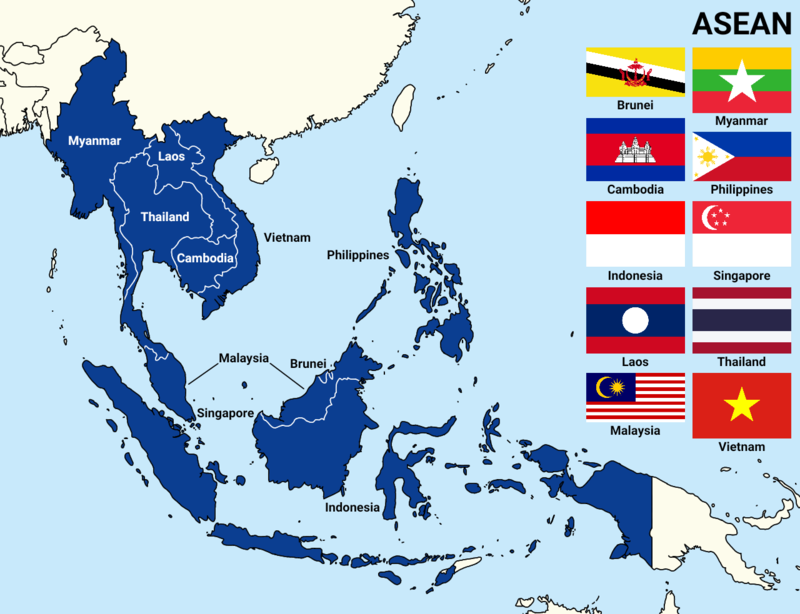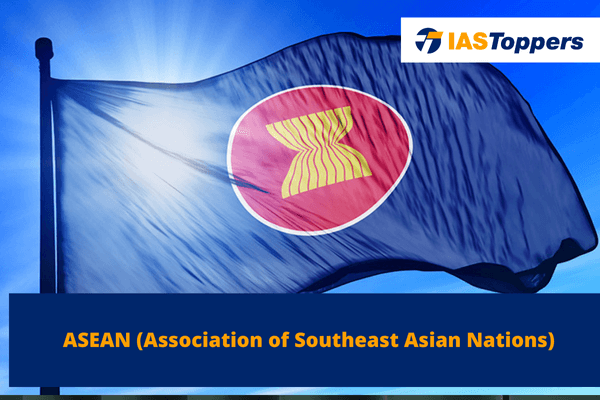The Association of Southeast Asian Nations (ASEAN) is a regional grouping that aims to promote economic and security cooperation in Southeast Asia. It comprises of total 10 members out of which five are founding members. ASEAN has played a central role in Asian economic integration, joining negotiations to form the world’s largest free trade agreement and signing six free trade deals with other regional economies.
ASEAN (Association of Southeast Asian Nations) will be helpful for UPSC IAS Exam preparation. GS Paper-2 International Relations.
Table of Content
- What is ASEAN?
- Origin (Background)
- ASEAN Countries
- ASEAN Aims and Purposes ASEAN
- ASEAN Objectives
- ASEAN Principles
- ASEAN-led Forums
- Challenges Faced by ASEAN
- Conclusion
- Frequently Asked Questions (FAQs)
What is ASEAN?
- The Association of Southeast Asian Nations (ASEAN) was founded on 8th August 1967, in Bangkok by the five founding members.
- Five Founding Members: Indonesia, Malaysia, the Philippines, Singapore, and Thailand.
- Inclusion of other members:
- Brunei Darussalam became a member on January 8, 1984,
- Vietnam on July 28, 1995,
- Lao PDR and Myanmar on July 23, 1997, and
- Cambodia on April 30, 1999.
- Headquarters: Jakarta, Indonesia.
- Official Languages: Burmese, Filipino, Indonesian, Khmer, Lao, Malay, Mandarin, Tamil, Thai and Vietnamese.
- The ASEAN region has-
- Population: approximately 500 million people,Total area: 4.5 million square kilometers,Combined GDP: nearly US$ 700 billion, and
- Total trade: approximately US$ 850 billion.

Origin (Background)
- Before ASEAN, an organization named the Association of Southeast Asia (ASA) was formed on July 31, 1961.
- It consisted of Thailand, the Philippines, and the Federation of Malaya.
- ASEAN was established on August 8, 1967, with the signing of the ASEAN Declaration by the foreign ministers of Indonesia, Malaysia, the Philippines, Singapore, and Thailand.
- Its creation was initially driven by the aim to contain communism.
- Communism gained ground in mainland Asia after World War II through the establishment of communist governments in various countries.
- First meeting of ASEAN: It took place in Bali, Indonesia in 1976.
- It led to agreements on industrial projects, the signing of the Treaty of Amity and Cooperation, and the Declaration of Concord.
- ASEAN countries gained greater political independence and emerged as influential voices on regional trade and security matters in the 1990s.
Southeast Asian Nuclear-Weapon-Free Zone Treaty
- Southeast Asian Nuclear-Weapon-Free Zone Treaty was signed on December 15, 1995.
- Aim: to establish a nuclear-weapon-free zone in Southeast Asia.
- The treaty became effective on June 21, 2001, after ratification by all but one of the member states, effectively prohibiting the presence of nuclear weapons in the region.
Expansion
- Brunei became the sixth member of ASEAN in 1984.
- Vietnam joined as the seventh member in 1995.
- Laos and Myanmar (formerly Burma) became members of ASEAN in 1997.
- Cambodia became a member in 1999.
- ASEAN was granted observer status at the United Nations General Assembly in 2006.
- In response, the United Nations was awarded the status of “dialogue partner” by the ASEAN.
ASEAN Countries

- ASEAN comprises of 10 member countries in Southeast Asia.
- ASEAN Member Countries include Brunei, Cambodia, Indonesia, Laos, Malaysia, Myanmar, the Philippines, Singapore, Thailand, and Vietnam.
ASEAN Objectives
As set out in the Declaration, the aims and purposes of ASEAN are set out in the ASEAN Declaration. These are to-
- Drive economic growth, social progress, and cultural development in the region
- Foster regional peace, collaboration, and mutual assistance on common interests
- Offer training and research facilities to support each other
- Enhance agriculture and industry for improved living standards
- Promote Southeast Asian studies
- Maintain beneficial cooperation with international organizations sharing similar aims
ASEAN Principles
- Mutual respect for all nations’ independence, sovereignty, equality, territorial integrity, and national identity,
- The right of every State to lead its national existence free from external interference, subversion, or coercion,
- Non-interference in one another’s internal affairs,
- Peaceful resolution of differences or disputes,
- Renunciation of the threat or use of force,
- Effective cooperation among themselves.
ASEAN-led Forums
ASEAN Regional Forum (ARF)
- ARF was established in 1993.
- It is a multilateral group consisting of twenty-seven members.
- Aim: to promote cooperation on political and security matters, fostering regional confidence-building and preventive diplomacy.
ASEAN Plus Three
- It is a consultative group formed in 1997.
- It brings together the ten ASEAN member countries with China, Japan, and South Korea.
East Asia Summit (EAS)
- EAS was established in 2005.
- Objective: enhancing security and prosperity in the region.
- It gathers the heads of state from ASEAN, Australia, China, India, Japan, New Zealand, Russia, South Korea, and the United States.
ASEAN Defence Ministers Meeting (ADMM)-Plus Meeting
- ADMM-Plus serves as a platform for ASEAN and its eight Dialogue Partners.
- Aim: to strengthen security and defence cooperation, promoting peace, stability, and development in the region.
ADMM-Plus Countries
- ADMM-Plus encompasses the ten ASEAN Member States along with eight Plus countries.
- These countries are Australia, China, India, Japan, New Zealand, South Korea, the Russian Federation, and the United States.
First ADMM-Plus
- It was inaugurated in a meeting that was held in Ha Noi, Vietnam, in 2010.
Challenges Faced by ASEAN
- Security Challenges in ASEAN: ASEAN faces various security challenges, such as-
- China’s territorial claims in the South China Sea,
- Human rights abuses,
- Political repression within member states,
- Narcotics trafficking,
- Refugee movements,
- Natural disasters, and
- Terrorism.
- Military Coup in Myanmar: ASEAN’s recent focus has been on formulating a collective response to the coup that occurred in Myanmar in February 2021.
- The junta’s violent suppression of protests has led to an escalation of conflicts, resulting in a civil war.
- However, ASEAN’s response has been constrained by internal divisions.
- The junta’s violent suppression of protests has led to an escalation of conflicts, resulting in a civil war.
- Divergent Views within ASEAN: Cambodia, Laos, Thailand, and Vietnam maintain close ties with the military junta in Myanmar and advocate for ASEAN’s recognition of the junta.
- Malaysia and Indonesia have urged ASEAN to take the unprecedented step of excluding junta leader Senior General Min Aung Hlaing from significant summits.
- Response to China: A persistent challenge for ASEAN has been to formulate a collective response to China specifically regarding maritime disputes in the South China Sea.
- Territorial Claims: Brunei, Indonesia, Malaysia, the Philippines, and Vietnam assert their ownership of features in the contested waters of the South China Sea, viewing China’s land reclamation and artificial island construction as violations of their sovereignty.
- Diverse Approaches: Some countries within ASEAN have focused on enhancing their military capabilities in response to tensions in the South China Sea.
- For other member states, the disputes are geographically distant and not a top priority.
- Countries like Cambodia tend to support China’s claims and obstruct joint ASEAN statements on the issue.
- Declaration of Conduct: ASEAN and China signed a nonbinding Declaration of Conduct of Parties in the South China Sea in 2002,.
- However, a legally binding code has not yet been negotiated.
- US Engagement: The US continues to engage in military cooperation with ASEAN members, including the Philippines, Thailand, and Vietnam.
- It has also increased its maritime presence to safeguard freedom of navigation in international waters.
- Division over China and US: ASEAN member states hold divergent views regarding their relationships with China and the United States.
- While China offers investment, trade, and infrastructure development through initiatives like the Belt and Road Initiative, some member states express concerns about economic dependence.
- Many seek defense cooperation with the United States as a counterbalance to China’s growing military power.
Response to China
- A long-standing challenge has been forming a joint response to China, particularly to maritime disputes with Beijing in the South China Sea.
- Brunei, Indonesia, Malaysia, the Philippines, and Vietnam claim features in waters contested with China.
- For those countries, China’s moves to reclaim land and build artificial islands are seen as violations of their national sovereignty.
- In response, some have invested in modernizing their militaries.
- For other ASEAN members, tensions in the South China Sea are geographically distant and not a priority.
- A few, such as Cambodia, even tend to support China’s claims and block joint ASEAN statements on the South China Sea.
- In 2002, ASEAN and China signed the nonbinding Declaration of Conduct of Parties in the South China Sea, though they have not yet negotiated a legally binding code.
- The United States, which has a strong interest in preventing China from controlling access to the South China Sea, has continued military cooperation with ASEAN members, including the Philippines, Thailand, and Vietnam, and has increased its maritime presence to enforce freedom of navigation in international waters.
Division over ties with China and US
- ASEAN members are divided over their ties to China and to the United States.
- The region is in need of investment, trade, and infrastructure development, and China has moved to meet these needs, most recently through its Belt and Road Initiative.
- But member states are anxious about becoming economically dependent on China, and many seek defence cooperation with the United States to hedge against China’s growing military power.
Conclusion
ASEAN’s impact is limited by a lack of strategic vision, diverging priorities among member states, and weak leadership. ASEAN’s biggest challenges are developing a unified approach to China, particularly in response to territorial disputes in the South China Sea, and responding to Myanmar’s civil war
Ref: Source-1
FAQs (Frequently Asked Questions)
What is the full form of ASEAN?
ASEAN stands for Association of Southeast Asian Nations.
When was ASEAN established and by whom?
ASEAN was formed On 8 August 1967 by five countries namely Indonesia, Malaysia, Philippines, Singapore and Thailand.
Is India a member of ASEAN?
No, India is not a part of ASEAN but it is part of the ASEAN Plus Six grouping. This grouping also includes China, Japan, South Korea, New Zealand and Australia.

